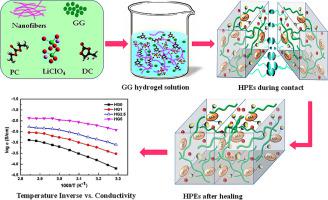Reactive & Functional Polymers ( IF 5.1 ) Pub Date : 2023-12-30 , DOI: 10.1016/j.reactfunctpolym.2023.105822 M. Deka , Yashibenla Longkumar , Bitupon Boruah , Himadree Sarmah , Madhabi Konwar , Lakhya J. Borthakur

|
An inventive concept towards the implementation of green energy-storing devices is the synthesis of hydrogel-based gel electrolytes from biopolymers imbued with self-healing capabilities. However, these electrolytes have drawbacks, such as low mechanical stability due to inadequate cross-linking and limited ionic conductivity compared to synthetic polymers. This work develops and characterizes a flexible self-healing hydrogel polymer electrolytes (HPEs) based on guar gum (GG) hydrogel for use in energy storage devices. Hydrogel is prepared with silicon dioxide (SiO2) nanofibers dispersed into borax-bonding cross-linked guar gum. Propylene carbonate (PC) and diethyl carbonate (DC) in equal amounts and lithium perchlorate (LiClO4) are used as plasticizers and salt, respectively. It has been found that adding nanofibers to the hydrogel and spreading them there considerably increases the ionic conductivity as evaluated by ac impedance spectroscopy. When the nanofiber concentration is 5 wt% (wt%), the hydrogel electrolytes reach their maximum room temperature ionic conductivity of 4.3 × 10−3 S cm−1. XRD, FTIR, SEM, and XPS investigations are used to explain the enhanced conductivity caused by the dispersion of nanofibers. Nanofibers also improve the self-healing abilities of materials, as demonstrated by the fact that hydrogels loaded with 5 wt% nanofibers recover from deformation more quickly than hydrogels with lower nanofiber contents. Additionally, the dispersion of nanofibers enhances the hydrogel's mechanical and thermal properties. According to electrochemical investigations and linear sweep voltammetry (LSV) graphs, hydrogel electrolytes are stable up to 4.7 V. When compared to nanofiber-free hydrogels, nanofiber-integrated hydrogel electrolytes show more excellent interfacial stability. The developed self-healing hydrogel-based polymer electrolytes exhibit outstanding promise for a range of energy storage systems, opening the way for creating high-performance and environmentally friendly energy storage solutions.
中文翻译:

硼砂交联瓜尔胶水凝胶基自愈聚合物电解质填充陶瓷纳米纤维面向高性能绿色能源存储应用
实现绿色储能装置的一个创造性概念是从具有自愈能力的生物聚合物合成基于水凝胶的凝胶电解质。然而,这些电解质具有缺点,例如与合成聚合物相比,由于交联不足而导致机械稳定性低以及离子电导率有限。这项工作开发并表征了一种基于瓜尔胶(GG)水凝胶的柔性自修复水凝胶聚合物电解质(HPE),用于储能设备。水凝胶是用二氧化硅(SiO 2)纳米纤维分散到硼砂键合的交联瓜尔胶中制备的。等量的碳酸丙烯酯(PC)和碳酸二乙酯(DC)以及高氯酸锂(LiClO 4 )分别用作增塑剂和盐。已经发现,通过交流阻抗谱评估,将纳米纤维添加到水凝胶中并将其铺展到那里可显着提高离子电导率。当纳米纤维浓度为5wt%(wt%)时,水凝胶电解质达到最大室温离子电导率4.3×10 -3 S cm -1。XRD、FTIR、SEM 和 XPS 研究用于解释纳米纤维分散引起的电导率增强。纳米纤维还提高了材料的自修复能力,事实证明,负载 5 wt% 纳米纤维的水凝胶比纳米纤维含量较低的水凝胶从变形中恢复得更快。此外,纳米纤维的分散增强了水凝胶的机械和热性能。根据电化学研究和线性扫描伏安法(LSV)图,水凝胶电解质在高达 4.7 V 的电压下稳定。与不含纳米纤维的水凝胶相比,纳米纤维集成的水凝胶电解质表现出更优异的界面稳定性。所开发的基于水凝胶的自修复聚合物电解质在一系列储能系统中表现出出色的前景,为创建高性能和环保的储能解决方案开辟了道路。



























 京公网安备 11010802027423号
京公网安备 11010802027423号